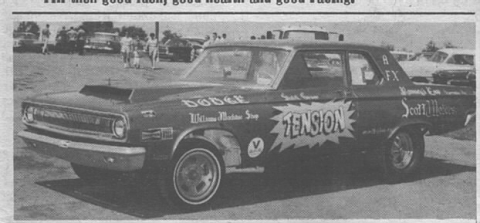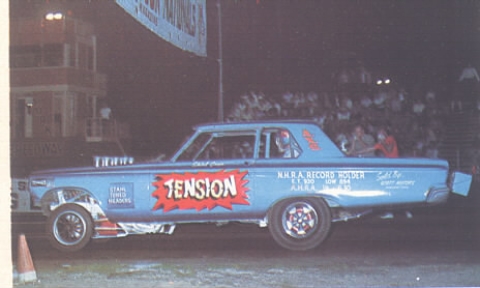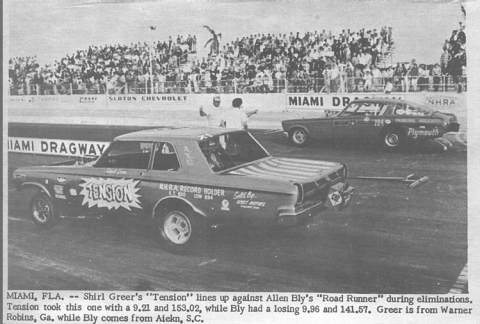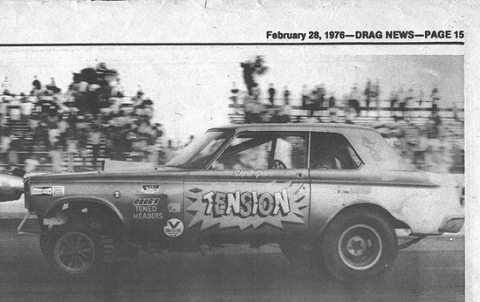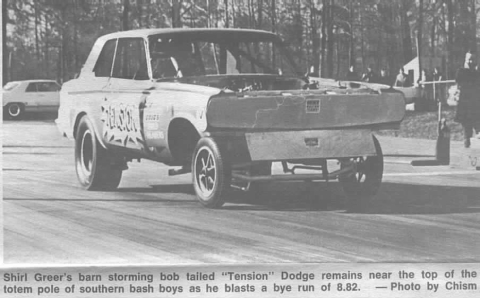


We’re not sure when the photo was taken but we’d bet it was just a few months after independent Tennessee drag racer Shirl Greer first took delivery of this factory fresh ’65 Super Stock Dodge. We can see that he has already made a number of changes to the basic WO1 /A990 package. A close look reveals: 1) Elimination of the door vent windows, probably following a switch to fiberglass doors in place of the thin-gauge factory doors to save about 40 pounds. 2) Possible rear wheel opening enlargement at the forward edge to accommodate larger slicks. Remember, the 1965 RO1 and WO1 cars featured a one-inch rear axle forward push that ate up precious fender lip clearance. 3) A taller FX-specific fiberglass Chrysler hood scoop in place of thin steel A-990 item to grab more air. 4) Skinny Halibrand front rims and 7-inch wide Cragar S/S rear rims replace the stock 14-inch steel Chrysler front and rear wheels which were only meant for temporary use prior to racing. 5) The C-pillar shows hand painted A/FX graphics, a clear indication that Shirl’s head was tuned into the freestyle world of match racing, and not the rigid realm of rulebook Super Stock action. 6) Elimination of the driver-side windshield wiper assembly despite the fact Chrysler already removed the passenger-side wiper on every WO1. 7) The factory applied white paint is still clearly visible behind the front tire, as is a stock appearing inner fender apron. It is likely the car retains its stock torsion bar front suspension in this picture. 8) The front bumper lacks the chrome plating found on factory installed WO1 applications. It is likely a lightweight fiberglass replacement with silver paint.
Major changes have obviously been made here as Shirl became more active on the match race circuit. But here he’s seen approaching the starting line at the 1966 Super Stock Nationals on August 5, 1966 where the car ran as quick as 9.22 at 149.75 in the 24F class (2400 pounds, burning nitro). We can see: 1) Major wheelbase re-location surgery has been done in much the same fashion as Chrysler’s 10 / 15-inch ’65 A/FX hardtop fleet. The front fenders are likely from Chrysler’s FX parts supplier, Plaza Fiberglass. The rear wheel opening modification work was likely performed by Shirl and his team. 2) The stock front suspension has been replaced with a straight axle, transverse Ford Model A-style leaf spring and twin radius rods. Undoubtedly this was done to shed weight. 3) The stock 10-inch front drum brakes and hubs have been eliminated. In their place is a pair of Halibrand straight-spoke rims that are mounted directly to the spindles rather than the stock 5-bolt wheel hubs. More weight was pared by this modification. 4) A brace of spun aluminum ram tubes indicate the presence of Hilborn mechanical fuel injection. The factory cross-ram carburetion setup was 40-hp less potent on gasoline. Going further, the Hilborn induction opened the door to alcohol and nitromethane fuels, unthinkable with standard Holley carburetors. 5) All side window glass has been removed for reduced mass and there is no door handle, just a bare mounting hole in the fiberglass door skin. 6) Shirl bucked the factory-backed FX trend of retaining the stock driving positioning and positioned the driver seat directly atop the rear axle. A novel center-steer arrangement was fab’ed to restore control. Clearly Shirl was hip to the magic of getting as much mass pushed to the rear of the car as possible. It all adds up and enhances static and dynamic weight distribution for maximum traction. 7) The rear rims are still 7-inches wide, but have been changed to Keystones. 8) A curious metal box is affixed to the rear deck lid. It is either a ballast box or, more likely a parachute holder. Remember, this thing only has rear drum brakes so a ‘chute would have been mandatory to get it safely stopped from any speed over 75 mph or so. 9) The previous A/FX logo on the C-pillar has been updated to A/XS (A, Experimental Stock) to reflect its intended competition in the more or less no-holds-barred XS category. 10) The front bumper has been removed, shaving 6 or 7 pounds. |
Shown in action at Miami Dragway against what appears to be the stretched nose Dorsey-Salter Krazy Kuda, Shirl has made even more refinements for enhanced performance. Looking closely we notice the following: 1) The rear wheel openings have been enlarged into semi-circular arches for even more tire clearance. 2) Updated lightweight aluminum rear rims and drag slicks may be 16-inch diameter. They’re from Dragster applications for even more traction than the 15-inch Keystone rims and slicks used previously. 3) The trunk lid appears to be sagging a bunch, likely due to the fact it is made of ultra-thin fiberglass which is barely strong enough to support its own weight. But then again, all it had to do was be as light as possible. As a pin-on panel, the lightweight trunk lid doesn’t have to be rigid enough for compatibility with hinges or a conventional latch.
Look closely at the rear end of the car Shirl chopped it off! We’re not sure if this was a quick remedy for an unfortunate accident or if it was all part of the plan. Let’s explore further: 1) There is a crude hood scoop in place where previously the eight Hilborn ram tubes stuck through the flat hood. We’re pretty sure Shirl never ran a GMC-style supercharger on this car, so the scoop was likely an effort to gather more concentrated air for ingestion. 2) A small flat air foil appears to be mounted below the grill. As more and more funny cars of the day broke the 150-mph barrier, many began to fly at top speed with ugly results. Shirl’s basic spoiler helped direct a portion of the air blast over the car to reduce lifting forces and perhaps even deliver some down force. Though crude, lots of other funny car teams quickly adopted similar devices to control lift. 3) Did we mention the entire trunk has been lobbed off the body? Yep, that’s a vestigal rear bumper (undoubtedly made of fiberglass) attached to the abbreviated rear quarter panel. Usually rear overhang is good for traction but in this case, there was probably plenty of traction with those massive digger slicks. No doubt the “trunk-ated” body dropped at least 100-pounds during surgery, a smart move that improved the power-to-weight ratio a bunch.
Near the end of its useful life, the once proud WO1 Dodge has been thoroughly butchered in just a few short years. But in historical context, that wasn’t a bad thing. According to the photo caption, the car ran an 8.82 at this southern match race. Final insults include: 1) The Hemi appears to have been relocated rearward in the chassis since the ram tubes look to be partially covered by the cowl. Moving the mass of the engine further rearward is just as effective as moving the axles forward when better traction is desired IF the rule book allows it. No doubt Shirl’s hope was to stay as close as possible to the new breed of fiberglass flip-top tube frame funny cars with this steel-shell door slammer. 2) Look hard and you’ll see a rear-facing square air vent mounted to the front fender (behind the tire). As trap speeds increased, funny car tams experimented with lots of ways to exhaust trapped air from inside the body shell. This was Shirl’s effort. 3) The grill has been replaced with a simple non-vented aluminum panel. Again, the wind resistance of this non-vented plug was the lesser evil compared to allowing high speed air to enter the body and cause lift. 4) The windshield seems to have been eliminated. Again, the thinking was probably that high speed air was best allowed to flow through the upper body than over it as trap speeds surpassed 160-mph. Some might predict that the roof panel could become an unwanted wing and lift the car, but Shirl lived to race for another decade so clearly it wasn’t a big problem here. Other racers frequently removed the roof all together and became roadsters Cecil Yother’s Melrose Missile ’65 Plymouth AWB is a prime example. But most fans (and track promoters) shunned roadsters since they sacrificed too much product identity. |













